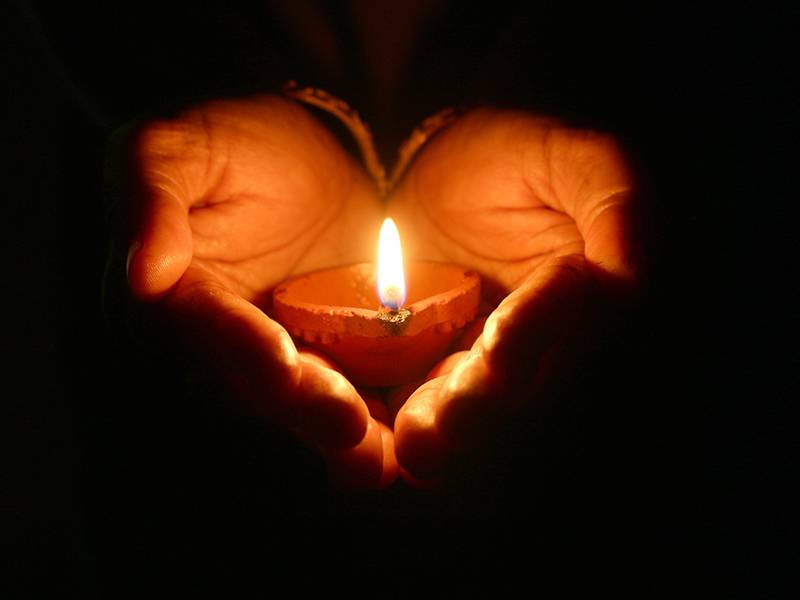Bonjour / Hello [nickname_else_first_name]
Table of contents
1) Perashat Hashavoua - Rabbi Eli Mansour
2) Halakhat Hashavoua (Halakhot related to day to day life) By Hazzan David Azerad
The Mitzvah of Lighting Shabbat Candles - Peninei Halacha
3) Holy Jokes!
4) For KIDS

This Week's Parasha Insight with Rabbi Eli Mansour
Parashat Bereshit: Producing Biological and Spiritual Children
There is a longstanding tradition among Torah scholars to find connections between the end of the Torah and the beginning of the Torah. This enterprise is aimed at underscoring the fact that the Torah is "circular," that the process of learning never ends, that we always have more knowledge and insight to gain. As we know, each year on Simhat Torah, as soon as we finish the Torah reading, we immediately read the first chapter of the Torah, demonstrating that we never consider ourselves "finished" learning Torah. Some have suggested that this is the deep meaning of the "Hakafot," our dancing in circles on Simhat Torah to celebrate the conclusion of the Torah reading. We dance in circles to show that Torah is "circular," that there is no beginning and no end. Similarly, Darshanim (lecturers) throughout the ages have sought to identify connections between the end of the Torah and the beginning, as part of this effort to emphasize the "circular" nature of Torah learning.
One such connection is drawn by Rav Haim Palachi (Turkey, 1788-1868), in his work Birkat Moadecha Le’Haim. He writes that if a couple is struggling to conceive, they should donate a Sefer Torah, as this is a Segula for begetting children. The reason, Rav Palagi explains, is that the final Misva in the Torah is the Misva to write a Sefer Torah (Debarim 31:19), and the first Misva in the Torah is "Peru U’rebu" – the obligation to procreate (Bereshit 1:28). These two Misvot are closely linked to one another, and thus in the merit of writing a Sefer Torah, one earns the privilege of fulfilling the Misva of "Peru U’rebu."
On a deeper level, the Kabbalists explain that there are two forms of "procreation" in which we are to involve ourselves. The first, and more obvious, form is biological procreation. Quite simply, we are required to try to beget and raise children. But in addition, we are bidden to involve ourselves in spiritual procreation, to produce Kedusha. This is done by writing Torah scrolls, but also by producing other forms of Torah literature. The Tur (Rabbenu Yaakob Ben Asher, 1269-1343) cites his father, the Rosh (Rabbenu Asher Ben Yehiel, Germany-Spain, 1250-1327), as ruling that nowadays, when we learn not from Torah scrolls, but from texts such as the Talmud and its commentaries, we fulfill the Misva of writing a Sefer Torah by producing and purchasing these texts. Accordingly, the Kabbalists teach, when a Torah scholar conceives of new Torah insights and writes them down, this is a form of "procreation." The pen is comparable to the male, and the paper corresponds to the woman. Just as a man impregnates a woman to produce a child, the pen applies ink to the paper to produce a "child" – written Torah.
It has been suggested that this is why the Tur and Shulhan Aruch present the laws of writing a Torah scroll in the 270th chapter of the Yoreh De’a section. The letters representing the number 270 are "Ayin" and "Resh," which spell "Er" – the name of Yehuda’s son, who, as we read in Parashat Vayesheb (Bereshit 38), did not want to produce children, and engaged in marital relations in a manner that would not result in conception. This sin is rectified not only through begetting biological children, but also by begetting spiritual children, by writing Sifreh Torah and other books of Torah literature, whereby we increase sanctity and spirituality in the world.
May Hashem grant us the assistance we need to both produce and raise biological offspring, and also produce holiness in the world through our efforts to learn Torah and facilitate the proliferation of Torah learning throughout the Jewish Nation.

Halachot this week are selected and Translated by Hazzan David Azerad
The Mitzvah of Lighting Shabbat Candles - Peninei Halacha
There is a rabbinic mitzva to light a candle to honor Shabbat. There are three reasons for this: 1) to honor Shabbat, as a banquet without light is of no significance; 2) for oneg Shabbat, because one who cannot see his food does not enjoy it; 3) to bring shalom bayit (peace in the home), because one who cannot see his furniture and belongings trips over them and gets angry and irritable. It is so important to have light at the Shabbat table that the Sages stated that one who does not have enough money to buy a candle should go door to door begging for charity in order to buy it (SA 263:2).
One who has only a bit of money should first buy bread so he does not fast on Shabbat. After that, if he still has money left, he should buy a candle, and only then, if he can, should he buy wine for kiddush. This is because one may make kiddush over bread if necessary, and the light allows him to honor and enjoy Shabbat. It is more important to light a candle to honor Shabbat than to beautify kiddush with wine (Shabbat 23b; SA 263:1-2).
The Shabbat candles give profound expression to the essence of Shabbat. One mired in darkness cannot find what he is looking for; he stumbles over his furniture; his whole home seems chaotic to him. But the moment he lights the Shabbat candles, peace comes to his home. He understands that his furniture is there to serve him, and his belongings are all where they belong. Thus he is able to enjoy Shabbat at his festive meal. Similarly, when we look at the world superficially, it seems full of strife and war, hopelessly divided and conflicted. Each side thinks that only when it succeeds in getting rid of the opposition will it be able to rest, and thus the conflicts endlessly continue. But if one thinks a little more deeply and examines divine providence, the darkness disappears and the divine light is revealed. He realizes that the opposing sides actually complement one another, and there is a hand directing and leading the world toward perfection. Out of all the troubles and afflictions, redemption and comfort will emerge (see above, 1:15).
The Shabbat candles, which bring peace to the home by adding light, thus allude to the repair of the world that comes about by increasing the light of Torah and faith. This is the goal of Shabbat – to add the light of faith and Torah to the world. It seems that this is the reason for the great love that all Jews have for the mitzva of Shabbat candles: It alludes to the overarching goal of the Jewish people – to make peace by adding light.
With this in mind, one can understand the Sages’ statement that one who is meticulous about lighting Shabbat candles will be privileged to have children who are Torah scholars (Shabbat 23b). For by occupying oneself with the light of Shabbat, one merits having a child who adds the light of Torah to the world. Accordingly, after lighting the Shabbat candles, many women customarily pray that their sons become Torah scholars.
The Sages state in God’s name: “The glory of Shabbat is its candles. If one observes [the mitzvah of] Shabbat candles, I will show you the candles of Zion…. It will not be necessary for you to use the light of the sun to see; rather I will provide illumination for you with My glory…. In the future, the nations will walk by your light…. Why do you deserve all of this? Because of the candles you light for Shabbat” (Yalkut Shimoni, Beha’alotekha).
Bevirkat Shabbat Shalom Umevorach
David Azerad
3) HOLY JoKeS!!
Selection of funny snippets, loosely related to this weeks parashah or current events, to brighten your day



4) FOR KIDS

Click on the image above to open the youtube video
ACTIVITY - CREATION WHEEL (click on image to go to site)
















